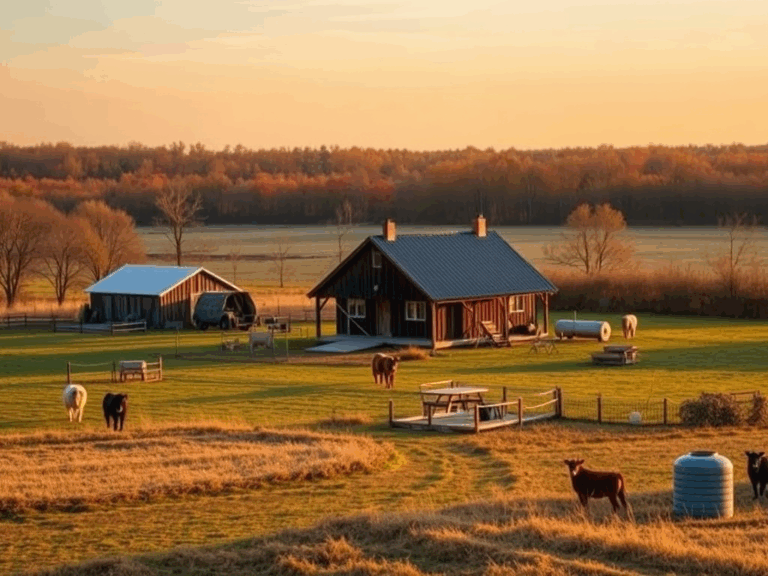If you think homesteading is all about hand-churned butter and sitting on the porch with a mason jar of something fermented while your chickens serenade you—well, okay, sometimes it is. But also? It’s about math. Spreadsheets. Hustling to keep the lights on and the goat feed stocked. Because while I adore this life, it sure doesn’t pay for itself in homegrown tomatoes.
Spoiler: It’s Not Just One Thing
I get asked all the time, “So… how do y’all afford to homestead full-time?” And the short answer is: we don’t put all our eggs in one basket. (Sometimes literally. Chickens are moody.)
We have multiple income streams—some traditional, some creative, some we basically invented out of panic and Pinterest. And while none of them alone would support the entire homestead, together they’ve built a life that works. Even if it is occasionally held together with duct tape and sourdough crumbs.
Let me break it down for you:
1. Farm Products (Yes, Even the Weird Ones)
We sell what we grow, make, and raise. But not always in the ways you’d expect.
Eggs
Of course we sell eggs. People love buying fresh, weirdly-shaped eggs from chickens with names like Dolly PartHen and Cluck Norris. We have regulars who swear our eggs make their pancakes fluffier. I don’t argue.
Veggies & Herbs
Every summer, I grow way more than we can eat or preserve, so we sell the extras—sometimes as CSA-style weekly boxes, sometimes at the farmers’ market, sometimes right off the porch with a Venmo sign and a cooler.
Also: Herbs sell surprisingly well. People will pay real money for a cute little bundle of fresh thyme if you tie it up with twine and smile a lot.
Honey & Beeswax
We got into beekeeping thinking it would be fun. (It is! Also terrifying.) But the honey? Gold. Literal liquid gold. We jar it, label it with cute names like “Back Acre Buzz,” and people go wild.
Meat
We raise some of our own meat—chickens, rabbits, the occasional hog—and we sell butcher shares locally. It’s a lot of work, but the customers are loyal and always come back for more. Especially when I throw in a free recipe card with their order.
2. The Farm Blog + Digital Products
Hello, it me—Nichole, your favorite accidental internet homestead personality.
Blogging started as a way to process my feelings about goat hoof trimming, but now it brings in consistent income. Between ads, affiliate links (yes, that’s the canner I actually use), and sponsored posts, it now covers everything from winter feed to emergency plumbing repairs.
I also create and sell downloadables—think pantry inventory sheets, seed-starting charts, and even homeschool planning pages. People LOVE a printable. I could probably slap a chicken illustration on a blank calendar and it would sell.
3. Workshops & Classes
A few times a year, I host workshops right here on the farm. Topics like:
- Sourdough 101 (we all cry at the starter phase, it’s fine)
- Beginner Chicken Keeping (spoiler: they poop a lot)
- Herbal Remedies From Your Backyard (aka what to do with that aggressive lemon balm)
We also do virtual classes now, thanks to Zoom. I once taught 60 people how to build a raised bed while my toddler painted the cat in the background. It was chaotic. And profitable.
4. Etsy-ish Craftiness
If it can be homemade, rustic, and slightly uneven—we probably sell it.
- Beeswax candles in vintage jelly jars
- Hand-poured goat milk soap (named things like “Barnyard Breeze”)
- Farm-themed wall art made from reclaimed barnwood
It’s part hobby, part income stream, part emotional support activity during long winters. And people eat it up.
5. Boarding & Bartering
This is one of those “didn’t plan it, but it works” setups.
A neighbor boards her horses on our pasture for a monthly fee. Another friend trades raw milk for eggs and helps us with fencing. Someone else drops off extra hay in exchange for help butchering their Thanksgiving turkey.
It’s not always cash, but it’s value. And around here, value feeds us just as well.
6. Odd Jobs + Off-Farm Work
Here’s the truth: my husband still picks up occasional contract work in town when things get tight. I also freelance write for a couple of farming magazines when I’m not deep in blog-world. And sometimes our neighbor pays us to haul junk out of her barn.
Homesteading teaches you humility. And how to say yes to weird gigs like “Can you build a chicken coop for my grandma’s birthday?” (We did. It had curtains.)
7. YouTube, Instagram, and the Internet Hustle
I hesitated to even mention this, because it still feels surreal. But yes, we make a little money from social media.
People watch our daily life videos, comment on our Instagram reels about cow escapades, and even buy from our affiliate links. It’s not enough to buy a tractor, but it covers things like new boots or a replacement heat lamp after the last one mysteriously melted. (I blame the goats.)
Real Talk: It’s a Patchwork Quilt of Income
We don’t have a single paycheck. We have many, many little ones—stitched together with grit, creativity, and a lot of late-night Googling like “how to market calendula salve to hipsters.”
Some months are great. Others are tight. Some weeks I sell out of bread before 9 a.m. Others I cry over a half-empty booth at the market and go home to eat all the unsold pickles myself.
But it works. And more importantly—it feels like ours.
So, Can You Really Make Money Homesteading?
Yes. But it’s not passive. It’s not instant. And it’s definitely not always pretty.
You have to diversify. Try things. Fail at things. Be the kind of person who can milk a goat in the morning, update your Shopify site by noon, and haul firewood at dusk.
It’s a lot.
But it’s also freedom. Flexibility. Fresh eggs. And the chance to build a life where your income is as handmade as your soap.
And in this world? That’s kind of priceless.
— Nichole 🐓💸🌿









